

When you send a letter from the U.S. to another country, the address may be a little different, but it's still easy and affordable: it only costs $1.65 to send a 1 oz letter (or postcard) using a USPS ® Global Forever ® stamp. For mail to U.S. destinations (including U.S. territories and APO/FPO/DPO addresses), see How to Send a Letter or Postcard: Domestic. For instructions on how to ship a package to another country, see How to Send a Package: International.
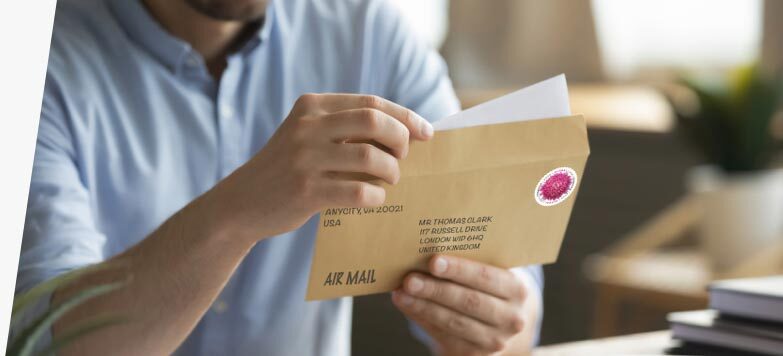
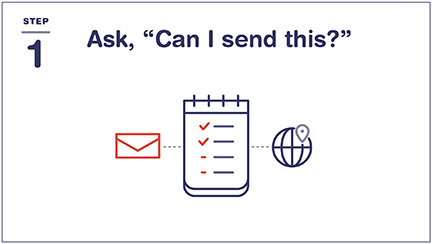
Different countries have different rules on what they’ll allow in. Look up your destination country in the Index of Countries and Localities to make sure you’re following their rules. If you’re just sending correspondence (no trading cards, bookmarks, stickers, etc.) or nonnegotiable documents (just paper; no cash, checks, or other items that have cash value), you don’t need a customs form. Show More
Reminder: You can only use First-Class Mail International ® service to send correspondence (like a personal or business letter) or other nonnegotiable documents in a letter that weighs up to 3.5 oz or large envelope that weighs under 15.994 oz.
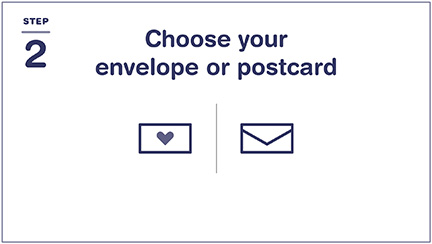
Envelopes are for sending paper documents like letters, cards, and forms. Postcards are for short messages that you don't need to put in an envelope. Show More
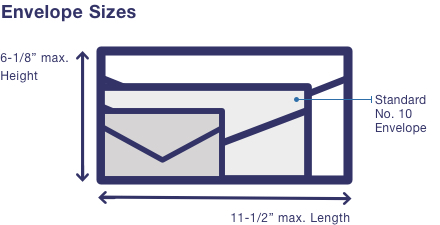
Just like U.S. letters, international letters must be rectangular and made of paper to qualify for letter prices. Letter envelopes for international mail can be 11-1/2" long x 6-1/8" high. (A standard No. 10 envelope is 9-1/2" long x 4-1/8" high.) You can fold what you put in your envelope, but it needs to stay flat—no more than 1/4" thick. TIP: If your letter can't fit through USPS ® mail processing equipment, it’s "nonmachinable" and you’ll have to pay $0.46 more to send it. (See additional postage in Step 4.) Nonmachinable items include envelopes that are lumpy or rigid, or have clasps, string, or buttons. You’ll also have to pay more if your envelopes are square or vertical (taller than they are wide). If you want to send letter-sized correspondence without folding it, you can use a large envelope (called a 'flat"); the postage for international flats starts at $3.15. If your large envelope is nonrectangular, rigid (can't bend), or lumpy (not uniformly thick), you'll have to pay the package price. Postcards: Standard postcards are usually made of thick paper (cardstock), are between 5-1/2" to 6" long and 3-1/2" to 4-1/4" high, and are no more than 0.016" thick. Sending a regular-sized, rectangular postcard from the U.S. to another country costs the same as sending a letter. Size & Weight Requirements – Postcards & Envelopes
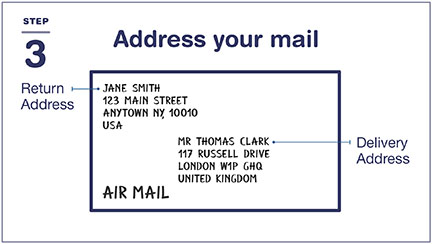
International address formats are different for each country. You also need to write the delivery address in English (if you need to use another language, add the English translation after each line).
Envelopes: Write your address (the "return" or "sender" address) in the top left corner (and put "USA" on the last line). Write the delivery address in the center (near the bottom). Put the destination country's name (in English) on the last line.
Postcards: Postcards come in different formats, so write the delivery address in the space it gives you (on the same side you write your message and put the stamp).
Print your return address and the delivery address clearly, in the correct spots, to make sure your mail is delivered on time.
Write your address in the U.S. (the “return address”) in the top-left corner. Include the following on separate lines:
Write the delivery address in the bottom center of the envelope.
You must write the delivery address in English, though you can include the delivery address in another language (like Russian, Greek, Arabic, Hebrew, Japanese, or Chinese), if you write the English translation after each line.
Many countries use different address formats (for example, the Postal Code might go before the city). Get specific information about other countries’ postal addresses by going to the Universal Postal Union and clicking "Postal Addressing Systems (PAS)".
Generally, include the following on separate lines:
Address Example (United Kingdom):
MR THOMAS CLARK
117 RUSSELL DRIVE
LONDON W1P 6HQ
UNITED KINGDOM
NOTE: If you're sending mail to a U.S. territory, U.S. military base, or U.S. embassy in another country (APO/FPO/DPO mail), see How to Send a Letter or Postcard: Domestic.
IMPORTANT: When you send using First-Class Mail International, you must write "AIRMAIL/PAR AVION" on the address side of your postcard, letter, or large envelope.
When you're done addressing your envelope, put what you’re sending inside the envelope, then close and seal it.
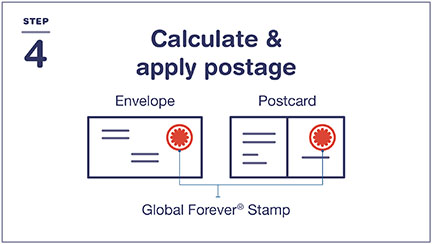 putting a Global Forever stamp on the same side as the address: top right for envelopes, and in the provided space on postcards." />
putting a Global Forever stamp on the same side as the address: top right for envelopes, and in the provided space on postcards." />
For just 1 $1.65 First-Class Mail International Global Forever stamp, you can send a 1 oz letter or postcard to any other country in the world.
Put stamps in the upper right corner of the envelope. (For postcards, put the stamp in the space provided near the delivery address.)
If your letter is heavier or bigger, if your postcard is large or square, or if you want to add extra services, you'll need to pay more.
Postage for international letters depends on weight, size/shape, and the price group of the country that you’re sending to. (See the Country Price Groups listing.)
You can weigh your letter with a kitchen scale, postal scale, at a self-service kiosk, or at the Post Office ™ counter.
TIP: As a rule of thumb, you can send a 1 oz letter (4 sheets of regular printer paper and a business-sized envelope) or a postcard—to any country in the world—for 1 First-Class Mail ® Global Forever stamp (currently $1.65). You can also use any other combination of stamps that adds up to $1.65.
The postage for a large envelope (or flat) starts at $3.15 for 1 oz.
If your letter weighs over 1 oz, you can buy additional postage in the amount you need, up to 3.5 oz. (Also, you can mail a large envelope that weighs up to 15.994 oz, paying the rate for large envelopes [flats].):
TIP: Put the stamp on last; that way, if you make a mistake at any other point, you won’t waste a stamp.
If you want insurance, proof of delivery, signature services, or other optional services, you’ll have to pay extra. Note that not all extra services are available for all products; our International Insurance & Extra Services page has more details.
When you go to the Post Office to mail First-Class Mail International letters, some of the more common extra services that you can add include:
A Note on Tracking: You can’t get tracking on First-Class Mail International letters. You can use Registered Mail service with Return Receipt, or use a USPS international package shipping service that offers tracking.
TIP: If you’re sending large envelopes (flats) using Priority Mail ® International, Priority Mail Express ® International, or First-Class Package International Service ® , you can use Click-N-Ship ® service to pay for and print your own postage online.
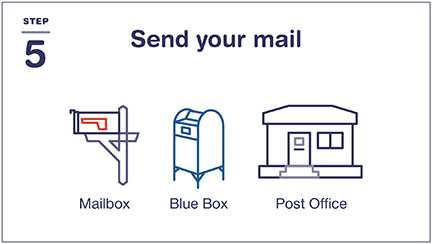
Once your envelope or postcard has the correct addresses and postage, you can send it several ways, including putting it in your mailbox or dropping it in a blue collection box or at a Post Office location.
Important Note: If your envelope has postage stamps and weighs more than 10 oz or is thicker than 1/2", you can't put it in a collection box; you have to give it to an employee at a Post Office location. See more details on What Can and Cannot be Deposited in a Collection Box ® ? (Also see specific guidance around dropping off mail that requires customs forms—though if you’re sending mail under 15.994 oz that’s just documents, you don’t need to do a customs form.)